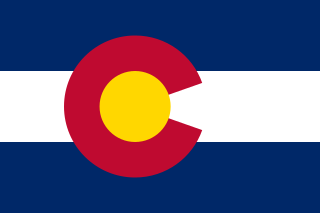
Echo Lake Park is a park located along the Mount Evans Scenic Byway about 33.5 mi (54 km) west of Denver, Colorado. The park provides a stone shelter with picnic tables and barbecue grills on one end of the lake, and the 1926 Echo Lake Lodge and an Arapaho National Forest campground are found at the other. Access to backpacking trails, including the Chicago Lakes trail and Lincoln Lakes trail, can be found adjacent to the lake. The park is part of the Denver Mountain Parks system.

There are more than 1,500 properties and historic districts in Colorado listed on the National Register of Historic Places. They are distributed over 63 of Colorado's 64 counties; only Broomfield County has none.
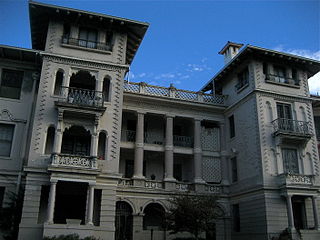
The Cornwall Apartments is a building on the National Register of Historic Places in the Capitol Hill section of Denver, Colorado. The apartments were designed by Denver architect Walter Rice in a Mexican colonial style that capturing a cosmopolitan spirit and gaiety in the unusual architectural elements for 1900, such as its balustrades, mouldings, and varied balconies. Reed made most of the terra cotta trim himself.
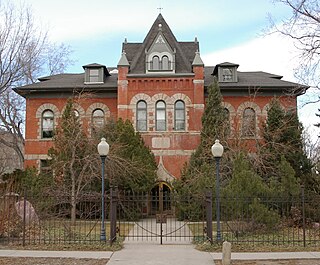
Highland School, also or previously known as Highland-Lawn School, is an 1892 building at 9th Street and Arapahoe Avenue in Boulder, Colorado. It was the fourth school built in Boulder and was used as a school until 1971. The Highland School Building was converted to use as an office building and placed on the National Register of Historic Places in 1978. The building is constructed of red brick and blond sandstone mined from local quarries.

The Colorado Governor's Mansion, also known as the Cheesman-Boettcher Mansion, is a historic U.S. mansion in Denver, Colorado. It is located at 400 East 8th Avenue. On December 3, 1969, it was added to the U.S. National Register of Historic Places. It is open free-of-charge for scheduled tours, and also hosts special public events.

The Watchman Lookout Station No. 168 is one of two fire lookout towers in Crater Lake National Park in southern Oregon. For many years, National Park Service personnel used the lookout to watch for wildfires during the summer months. It is also a common hiking destination because of its views of Crater Lake and the surrounding area. The building is unusual because it serves the dual purpose of fire lookout and museum. The Watchman Lookout Station is listed on the National Register of Historic Places.
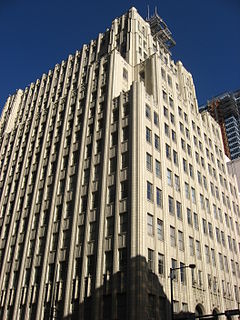
The Mountain States Telephone Building is a historic building located at 931 14th Street in Denver, Colorado. It was listed on the National Register of Historic Places on January 26, 2005.
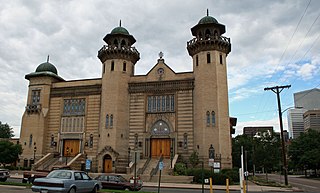
Temple Emanuel on Pearl Street in Denver, Colorado, is a building that was built in 1898–1899 and expanded in 1924. In 1957 the synagogue was sold to First Southern Baptist Church and then LovingWay Pentecostal Church in 1977. In 1986 the building was acquired by the city of Denver because of a foreclosure process.
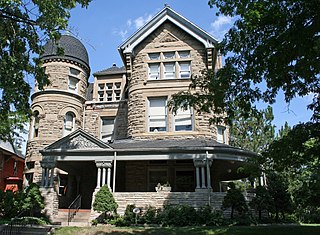
The Bailey House was built in 1889, and was designed by William A. Lang. The Bailey House, built for a Mr. G.W. Bailey, is the largest of William Lang's surviving residential residences. William A. Lang (1846–1897) was a Denver architect who was active from 1885 to 1893.

The Park Avenue Apartment District is a historic district in Omaha, Nebraska that was listed on the National Register of Historic Places in 2008.

St. Andrew's Episcopal Church, is an Anglo-catholic church in Denver, Colorado. Its building, "considered by many people to be one of Denver's most beautiful churches" is a Gothic style church built c.1907-1909 that was designed by architect Ralph Adams Cram. It was dedicated January 17, 1909 as Trinity Memorial Church and renamed to St. Andrews in 1917.

William Ellsworth Fisher was an architect who founded the Denver, Colorado firm that became Fisher & Fisher.

Midwest Steel & Iron Works was a metal fabrication company based in Denver, Colorado. Founded in 1893, the company was known for a time as the Jackson-Richter Iron Works. The company was one of the "oldest and largest metal fabricators" in Denver. The company built both structural and ornamental components for structures throughout Colorado, Wyoming and New Mexico. The company's headquarters on Larimer Street in Denver includes an Art Deco office building and consists of a four-building complex that is itself considered a historic industrial site. The complex served as the company's headquarters from 1923 to 1983.

John James Huddart (1856–1930), known usually as John J. Huddart, was a British born and trained architect who practised out of Denver, Colorado in the United States. At the end of the Nineteenth century he was one of Denver's leading architects, known for his work on public buildings and as a courthouse architect. His practice lasted from 1882 to 1930 and commissions included Charles Boettcher House in Denver, Colorado's Fort Morgan State Armory, Denver's Filbeck Building, and six of Colorado's county courthouses.
Frederick Albert Hale was an American architect who practiced in states including Colorado, Utah, and Wyoming. According to a 1977 NRHP nomination for the Keith-O'Brien Building in Salt Lake City, "Hale worked mostly in the classical styles and seemed equally adept at Beaux-Arts Classicism, Neo-Classical Revival or Georgian Revival." He also employed Shingle and Queen Anne styles for several residential structures. A number of his works are listed on the U.S. National Register of Historic Places.
Merrill H. Hoyt was a prominent American architect, business man and leader in the building design community of Denver, Colorado from 1910 to 1933.
Walter Rice, also known as Walter L. Rice (1866–1930), was an American architect, inventor, and engineer. He made a career as an architect in Denver, Colorado, particularly for the design of apartment buildings. Several of his buildings are designated National Register of Historic Places. He patented inventions for automobiles.

Flower-Vaile House is a historic house in North Capitol Hill, Denver, Colorado. The house was designed by Balcombe and Rice and built by D. S. Gray. It was designated a Denver Landmark on October 13, 1981 and was listed on the National Register of Historic Places on October 21, 1982. Richard R. Brettel described the house in Historic Denver as a prime example of "decorative or surface style eclecticism added to the basic Queen Anne Street house — very common in Denver by the mid- to late-1880s."

The Citizens National Bank Building, at 801 Grand Ave. in Glenwood Springs, Colorado, was built in 1913. It was listed on the National Register of Historic Places in 1999. It has also been known as the New Citizens Building. Besides serving as a financial institution, it has served as a specialty store and as a hotel.
The Ertel Funeral Home, at 42 N. Market St. in Cortez, Colorado, was listed on the National Register of Historic Places in 1995.


